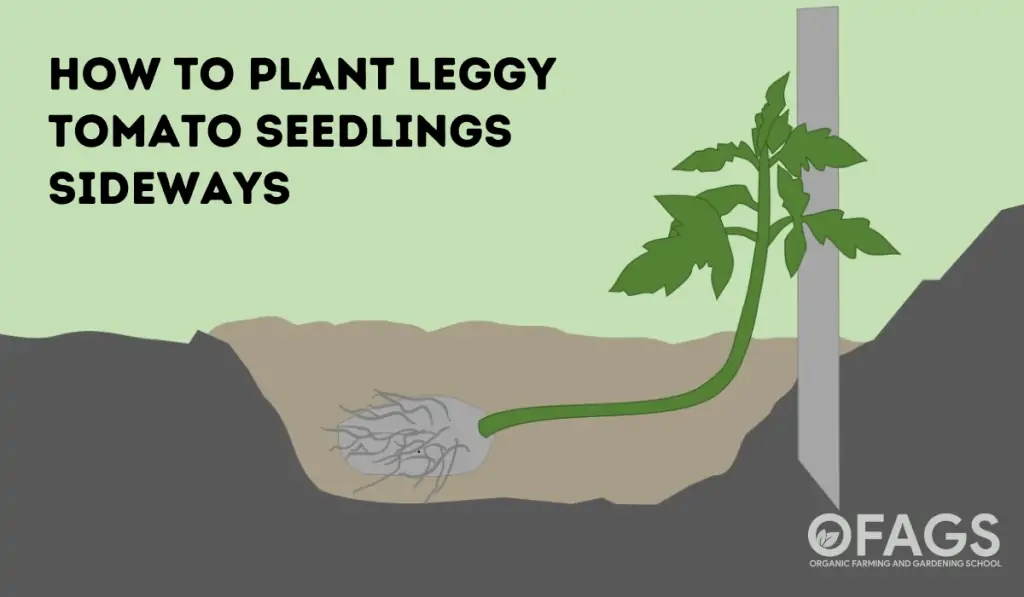Planting tomatoes sideways (also known as Trench Planting) is an innovative approach to address the challenges of leggy seedlings, turning a potential drawback into an advantage by promoting the development of a strong and extensive root system. Here’s a step-by-step explanation of how to plant tomatoes sideways and the reasons behind this method:

1. Choose the Right Seedlings:
- This method is ideal for leggy tomato seedlings, which are taller and thinner than ideal.
- Leggy seedlings often occur due to insufficient light or overcrowding in their initial growing conditions.
2. Hardening off the plants for few days:
- Set your tomato plant on its side for a 2-3 days before moving it to its final spot.
- This little trick prompts the upper portion of the main stem to naturally bend upwards.
- Adopting this method is crucial to ensure the stem grows straight and remains undamaged.
Learn more about hardening off tomatoes.
3. Prepare the Planting Site:
- Select a sunny location with well-draining soil.
- Ensure the site is prepared with compost or a balanced fertilizer to provide nutrients to the growing plants.
4. Dig a Horizontal Trench:
- Instead of a traditional vertical hole, dig a shallow, horizontal trench.
- The trench should be long enough to accommodate most of the tomato plant’s stem, typically about 4 to 6 inches deep.
5. Trim Lower Leaves:
- Remove the lower leaves from the tomato seedling, leaving only the top few sets of leaves.
- This step is important because the buried stem will sprout roots, and leaves left on the buried stem can rot.
6. Position the Plant Sideways:
- Lay the tomato plant sideways in the trench.
- The idea is to bury most of the stem, which will encourage root growth along the buried portion.
7. Bend the Top Upwards Gently:
- Carefully bend the top part of the seedling so it points upward, above the soil surface.
- This ensures that the growing tip of the plant receives sunlight and grows upwards.
8. Backfill the Trench:
- Gently cover the stem with soil, leaving the top leaves exposed.
- Firm the soil around the plant to ensure good contact and eliminate air pockets.
9. Water Thoroughly:
- Water the plant generously after planting to settle the soil and provide moisture to the roots.
- Consistent watering is crucial in the initial stages after planting.
10. Provide Support if Needed:
- If the plant is very tall, consider staking it to provide support as it grows.
Reasons Behind Planting Tomatoes Sideways:
Planting tomatoes sideways, often referred to as trench planting, is particularly beneficial for leggy seedlings for several reasons:
1. Enhanced Root Development:
Tomato plants have the ability to grow roots along their stems. When you plant seedlings sideways, more of the stem is in contact with the soil, allowing more roots to develop along the buried stem. This results in a stronger root system, which is crucial for nutrient and water uptake.
2. Sturdier Plants
Leggy seedlings usually have long, thin stems that can be weak and prone to bending or breaking. By planting them sideways and allowing roots to form along the stem, the plant becomes more robust and better able to support the weight of its leaves and fruit.
3. Improved Stability
A stronger root system provides better anchorage for the plant. This is particularly important in areas with strong winds or heavy rains, which can easily topple plants with weaker root systems.
4. Reduction of Initial Height
Leggy seedlings are often too tall and can struggle to stay upright. Planting them sideways allows you to effectively reduce their initial height, making them less top-heavy and more stable.
5. Better Adaptation to Outdoor Conditions
If the seedlings were grown in less than ideal conditions (like insufficient light), trench planting helps them adapt better to the outdoor environment by encouraging a more natural growth pattern.
6. Enhanced Water and Nutrient Absorption
A larger root system allows for better absorption of water and nutrients, crucial for healthy growth and fruit production.
7. Healthier Growth
With a more extensive root system and a sturdier stem, the tomato plant can grow more vigorously, leading to improved overall health and potentially a better yield.
8. Disease Resistance
A healthier plant with a robust root system is typically more resistant to diseases and pests.
Conclusion
In summary, trench planting transforms the disadvantage of a leggy stem into an advantage by utilizing it to develop a more extensive root system. This technique helps in stabilizing the plant, promoting healthier growth, and ultimately contributing to a more successful tomato harvest.
